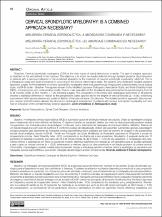Cervical spondylotic myelopathy: is a combined approach necessary?
Fecha
2019Autor(es)
Moncada Moreno, Luis Enrique
Oliveira Teixeira, Kelsen de
Dantas Matos, Thiago
Caiado Fleury, Rodrigo Barra
Tavares Costa, Herton Rodrigo
Aparecido Defino, Helton Luiz
Metadatos
Mostrar el registro completo del ítemResumen
Objective: Cervical spondylotic myelopathy (CSM) is the main cause of spinal dysfunction in adults. The type of surgical approach
to treatment is not well defined in the literature. The objective is to report the results obtained through isolated posterior decompression
in patients with a previous indication of the combined approach for the treatment of cervical spondylotic myelopathy. Methods: This is
a therapeutic study with level of evidence II, according to the Oxford classification table. Ten patients who underwent isolated posterior
approach surgery for the treatment of cervical spondylotic myelopathy were evaluated through imaging and questionnaires (visual analog
scale, mJOA-Br scale – Brazilian Portuguese version of the Modified Japanese Orthopedic Association Scale, and Neck Disability Index
(NDI)), comparing pre- and postoperative results. Results: Late evaluation of the 10 patients was performed in the period ranging from 24
to 36 months (mean of 30.3 months ± 7.25) following surgery. The comparison of the clinical and radiological parameters in all patients
showed a statistical difference in relation to the preoperative scales applied and to the degree of cervical lordosis (p <0.05), evidencing
improvement after decompression and posterior fixation of the cervical spine. Conclusions: The isolated posterior approach (decompres-
sion, fixation and arthrodesis) allowed the clinical and radiological improvement of patients with cervical spondylotic myelopathy and who
had an indication of the complementary anterior approach. Level of evidence II; Retrospective study
Colecciones
- Artículos [274]








